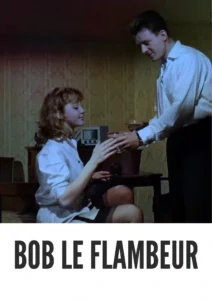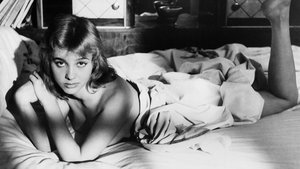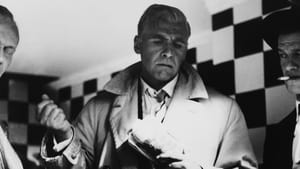Video Sources 0 Views
- Watch trailer
- Bob le Flambeur 1956 Colorized


Synopsis
Table of Contents
Toggle
Dive into the alluring world of Bob le Flambeur, a seminal film from 1956, now brilliantly colorized to capture the vibrant essence of post-war Paris. This stylish heist film, directed by Jean-Pierre Melville, masterfully blends elements of film noir with the emerging French New Wave. Featuring sharp dialogue, memorable characters, and a palpable sense of atmosphere, this HD download offers both classic film aficionados and newcomers a chance to experience a crucial piece of cinematic history.
Bob le Flambeur centers around Bob Montagné (Roger Duchesne), an aging gambler and former bank robber who finds himself down on his luck. Bob, a fixture of the Pigalle district’s late-night scene, is respected by both the criminal underworld and the local police. However, a streak of bad luck leaves him nearly broke.
When Bob overhears plans for a massive cash deposit at the Deauville casino, his gambling instincts kick in. He decides to plan one last heist to restore his fortune. As Bob meticulously prepares his scheme, a series of complications arise. A young protégé, Paulo, gets mixed up with a dangerous American gangster, and Bob finds himself falling for Anne, a charming young woman who may or may not be trustworthy. As the night of the heist approaches, Bob must contend with his own internal conflicts, the unpredictable nature of his accomplices, and the ever-present threat of the police, who are always one step behind. The film culminates in a suspenseful and ironic climax that solidifies its place in cinematic history. Bob le Flambeur is a stylish, atmospheric, and ultimately tragic tale of redemption, risk, and the seductive allure of the criminal life.
The film features a compelling cast of actors who bring the world of Bob to vivid life:
-
Roger Duchesne as Bob Montagné
-
Isabelle Corey as Anne
-
Daniel Cauchy as Paulo
-
Guy Decomble as Inspector Ledru
-
André Gille as Jean
Bob le Flambeur masterfully straddles multiple genres, standing as a cornerstone of both the French New Wave and heist film traditions. Its blend of gritty realism, stylish visuals, and existential themes make it a unique and influential piece of cinema.
Released in 1956, Bob le Flambeur arrived at a pivotal moment in French cinema. It anticipates many of the stylistic and thematic elements that would come to define the French New Wave, including location shooting, improvisational dialogue, and a focus on the lives of ordinary people. The film also reflects the social and cultural landscape of post-war France, with its themes of disillusionment, moral ambiguity, and the allure of the criminal underworld. Bob le Flambeur is a significant work that bridges the gap between classic film noir and the groundbreaking cinema of the French New Wave.
This colorized version of Bob le Flambeur has been carefully restored using state-of-the-art digital techniques, enhancing the visual experience while maintaining the film’s original atmosphere and artistic integrity. The colorization process involved extensive analysis of the original black and white footage, with meticulous attention paid to recreating the specific hues and tones of 1950s Paris. While the exact software utilized remains confidential, the methods employed include sophisticated algorithms for color palette selection and image enhancement. This painstaking process breathes new life into the characters and settings, making the story even more immersive for contemporary audiences. Although debates surrounding the colorization of classic films persist, this restoration aims to introduce Bob le Flambeur to a wider audience, ensuring its continued relevance and appreciation for generations to come.
-
: Jean-Pierre Melville
-
: Jean-Pierre Melville, Auguste Le Breton
-
: Henri Decaë
-
: Monique Bonnot
-
: Playtime Films, Société Générale de Cinématographie (S.G.C.)
-
: Ellis Films
-
: 98 minutes
-
: MP4
-
: HD (1080p)
-
: Compatible with most devices, including smartphones, tablets, computers, and smart TVs.
Bob le Flambeur is widely regarded as a landmark film, influencing countless filmmakers and solidifying Jean-Pierre Melville’s reputation as a master of suspense and atmosphere. Its innovative style, memorable characters, and morally ambiguous themes continue to resonate with audiences and critics alike.
-
: What is Bob le Flambeur about?
-
A: Bob le Flambeur is a heist film about an aging gambler who plans one last score to restore his fortune.
-
-
: Is Bob le Flambeur (1956) considered a classic film?
-
A: Yes, Bob le Flambeur is considered a classic of both the French New Wave and the heist genre.
-
-
: Is this version of Bob le Flambeur colorized?
-
A: Yes, this version has been professionally colorized to enhance the viewing experience.
-
-
: What makes Bob le Flambeur interesting for film enthusiasts?
-
A: Bob le Flambeur offers a unique blend of film noir and French New Wave elements, showcasing Jean-Pierre Melville’s innovative style and thematic depth.
-
-
: What is the download format?
-
A: The download format is MP4, which is compatible with most devices.
-
-
: What resolution is the download?
-
A: The resolution is HD (1080p), providing a high-quality viewing experience.
-
Watch Bob le Flambeur Today!












